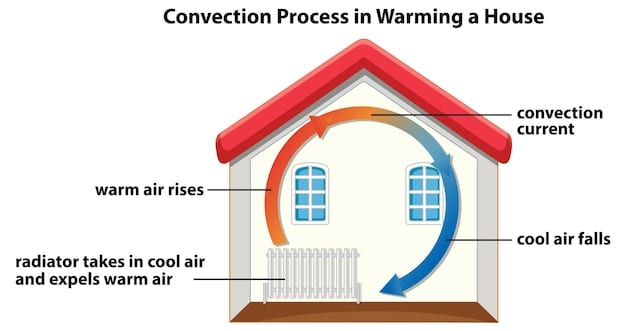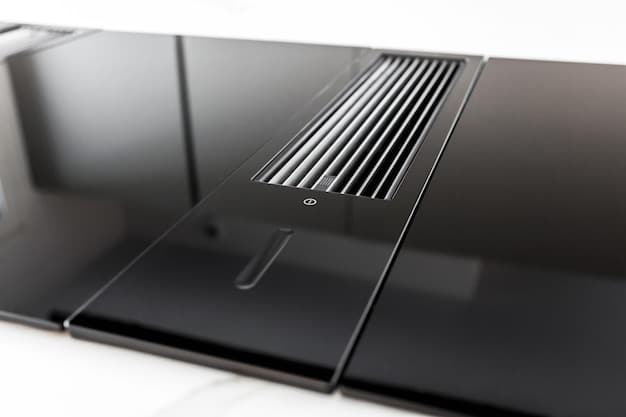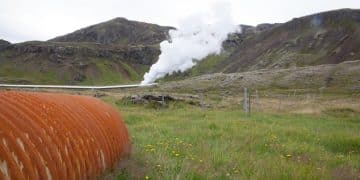Geothermal Energy: Powering US Homes in 2025

Geothermal energy harnesses the Earth’s internal heat for sustainable home heating and cooling, offering a reliable renewable energy source poised for increased adoption in the US by 2025.
Imagine tapping into the Earth’s constant, natural heat to warm your home in winter and cool it in summer, all while reducing your carbon footprint. Geothermal Energy: Unlocking the Earth’s Power for Home Heating and Cooling in 2025, is becoming an increasingly viable and attractive option for homeowners across the United States. Let’s explore how this renewable resource is set to transform residential energy consumption.
Understanding Geothermal Energy for Home Use
Geothermal energy, simply put, is heat derived from the Earth’s interior. This heat, continuously replenished, can be harnessed for various applications, including generating electricity and, more relevant to homeowners, heating and cooling buildings. How exactly does this work for residential properties?
Geothermal Heating and Cooling Systems
Geothermal systems, also known as ground source heat pumps (GSHPs), utilize the relatively constant temperature of the Earth a few feet below the surface. These systems consist of three main components: a ground loop, a heat pump unit, and a distribution system.
How Ground Source Heat Pumps Work
During the winter, the ground loop absorbs heat from the Earth and transfers it to the heat pump. The heat pump then concentrates this heat and distributes it throughout the home via a conventional ductwork or radiant heating system. In the summer, the process is reversed: the heat pump extracts heat from the home and transfers it to the ground, effectively cooling the building.
- Efficiency: GSHPs are significantly more efficient than traditional heating and cooling systems, often achieving efficiencies of 300-500%.
- Cost Savings: While the initial investment can be higher, the reduced energy consumption translates to substantial long-term cost savings.
- Environmental Benefits: Geothermal systems significantly reduce greenhouse gas emissions compared to fossil fuel-based systems.

In essence, geothermal systems offer a reliable, efficient, and environmentally friendly way to heat and cool homes. This technology is not just a futuristic concept; it’s a practical solution for homeowners looking to reduce their energy bills and environmental impact.
The Growing Adoption of Geothermal in the US
The adoption of geothermal energy for home heating and cooling is steadily increasing across the United States. Several factors are driving this growth, including rising energy costs, growing environmental awareness, and government incentives. Let’s examine some key trends in the US market.
Federal and State Incentives
Both federal and state governments offer various incentives to encourage homeowners to install geothermal systems. These incentives can include tax credits, rebates, and grants, significantly reducing the upfront cost of installation.
Market Growth Projections
Market research indicates a strong growth trajectory for the geothermal heating and cooling market in the US. Factors such as increasing demand for energy-efficient solutions and supportive government policies are expected to fuel this growth.
Key Players in the US Geothermal Market
Several companies are actively involved in the manufacturing, installation, and servicing of geothermal systems in the US. These companies play a crucial role in driving innovation and expanding the reach of geothermal technology.
Some of the top leaders in the US geothermal market include:
- Bosch Thermotechnology: Renowned for their efficient and reliable geothermal heat pumps.
- GeoComfort: Specializing in geothermal systems designed for residential and commercial applications.
- WaterFurnace Renewable Energy: A leading manufacturer of geothermal and water source heat pumps.
The increasing availability of incentives, coupled with a growing awareness of the benefits of geothermal energy, is driving significant growth in the US market. As technology advances and costs decrease, geothermal is poised to become an even more attractive option for homeowners.
Technological Advancements in Geothermal Systems
Ongoing research and development efforts are continuously improving the efficiency, reliability, and affordability of geothermal systems. These technological advancements are making geothermal energy an even more competitive option for home heating and cooling. What are some of the cutting-edge innovations?
Enhanced Heat Pump Technology
Manufacturers are constantly developing more efficient and reliable heat pump units. These advancements include improved compressor designs, advanced refrigerants, and smart controls that optimize system performance.
Improved Ground Loop Designs
Innovations in ground loop design are reducing installation costs and improving heat transfer efficiency. Techniques such as horizontal directional drilling and advanced materials are being used to create more effective ground loops.
Smart Home Integration
Modern geothermal systems can be integrated with smart home technology, allowing homeowners to control and monitor their systems remotely. This integration provides greater control, efficiency, and convenience.

The continuous evolution of geothermal technology is paving the way for more efficient, cost-effective, and user-friendly systems. These advancements are crucial for expanding the adoption of geothermal energy and realizing its full potential.
Cost Analysis: Geothermal vs. Traditional Systems
One of the key considerations for homeowners is the cost-effectiveness of geothermal systems compared to traditional heating and cooling options. While the initial investment may be higher, the long-term cost savings can be significant. How do these costs break down?
Initial Installation Costs
The initial cost of installing a geothermal system typically ranges from $20,000 to $30,000, depending on factors such as the size of the home, the type of ground loop, and local labor costs. This cost is generally higher than that of traditional HVAC systems.
Operating Costs and Energy Savings
Geothermal systems are significantly more energy-efficient than traditional systems, resulting in lower operating costs. Homeowners can typically save 30-70% on their heating and cooling bills with a geothermal system.
Return on Investment (ROI)
The return on investment for a geothermal system can be substantial, with payback periods ranging from 5 to 10 years, depending on energy prices and usage patterns. Over the long term, geothermal systems can provide significant cost savings and increase property value.
Understanding the cost dynamics of geothermal systems is essential for homeowners considering this option. While the upfront costs may seem daunting, the long-term savings and environmental benefits make geothermal a compelling investment.
Environmental Benefits of Geothermal Energy
Beyond cost savings, geothermal energy offers significant environmental benefits compared to fossil fuel-based heating and cooling systems. These benefits contribute to a more sustainable and environmentally responsible energy future. What are the key environmental advantages?
Reduced Greenhouse Gas Emissions
Geothermal systems produce significantly lower greenhouse gas emissions than traditional heating and cooling systems. This reduction helps to mitigate climate change and improve air quality.
Renewable and Sustainable Resource
Geothermal energy is a renewable resource that is continuously replenished by the Earth’s internal heat. This makes it a sustainable alternative to finite fossil fuels.
Decreased Reliance on Fossil Fuels
By using geothermal energy for home heating and cooling, homeowners can reduce their reliance on fossil fuels, contributing to greater energy independence and security.
- Lower Carbon Footprint: Geothermal systems have a significantly smaller carbon footprint compared to conventional systems.
- Reduced Air Pollution: Geothermal systems do not produce harmful air pollutants, such as nitrogen oxides and sulfur dioxide.
- Sustainable Heating and Cooling: Geothermal energy provides a sustainable solution for meeting heating and cooling needs.
The environmental benefits of geothermal energy are becoming increasingly important as society seeks to reduce its impact on the planet. By choosing geothermal, homeowners can make a positive contribution to a more sustainable future.
Future Outlook: Geothermal Energy in 2025 and Beyond
Looking ahead to 2025 and beyond, geothermal energy is poised to play an increasingly important role in the US energy landscape. Several factors are expected to drive further growth and adoption of geothermal technology. What does the future hold?
Increased Government Support
Continued government support, including tax credits, rebates, and research funding, will be crucial for fostering the growth of the geothermal industry. Supportive policies can help to lower costs, promote innovation, and accelerate adoption.
Technological Breakthroughs
Ongoing research and development efforts are expected to yield further technological breakthroughs that improve the efficiency, affordability, and accessibility of geothermal systems. These advancements could include enhanced heat pump designs, improved ground loop installation techniques, and smart grid integration.
Growing Consumer Awareness
As more homeowners become aware of the benefits of geothermal energy, demand for these systems is likely to increase. Educational initiatives, marketing campaigns, and positive word-of-mouth can help to raise awareness and drive adoption.
In conclusion, the future of geothermal energy in the US looks bright. With continued innovation, supportive policies, and growing consumer awareness, geothermal is well-positioned to become a mainstream solution for home heating and cooling, contributing to a more sustainable and energy-efficient future.
| Key Point | Brief Description |
|---|---|
| 🔥 Efficiency | Geothermal systems are much more efficient than traditional HVAC. |
| 💰 Cost Savings | Reduced energy use leads to long-term savings. |
| 🌎 Environmental Benefits | Lower emissions and sustainable energy source. |
| 📈 Market Growth | Increasing adoption due to cost and environmental factors. |
Frequently Asked Questions
▼
Geothermal energy is heat from within the Earth. It’s a renewable resource used for heating, cooling, and electricity generation, offering a sustainable alternative to fossil fuels.
▼
Geothermal systems use a ground loop to exchange heat with the Earth. In winter, heat is drawn from the ground; in summer, heat is transferred back into the ground, providing efficient temperature control.
▼
Geothermal energy provides cost savings, reduces greenhouse gas emissions, and offers a stable, renewable energy source independent of weather conditions, contributing to energy independence.
▼
The initial cost can range from $20,000 to $30,000, but incentives can lower this. Long-term savings on energy bills typically provide a return on investment within 5-10 years.
▼
Geothermal is suitable for many homes, but factors like soil type, land availability, and local climate should be considered. Consult with a geothermal professional to assess your property’s suitability.
Conclusion
As we look towards 2025, geothermal energy presents a promising solution for sustainable home heating and cooling in the US. With its numerous environmental and economic advantages, along with ongoing technological advancements and supportive government policies, geothermal energy is poised to become an increasingly important part of the renewable energy mix, offering homeowners a reliable and eco-friendly way to power their homes.





